Ajrakh
Just as various communities, the world over have their own symbolism, Ajrakh shawls is a signature garment of the Khatris. It is one of the rarest art forms that has survived for a long time. Literally translated into “keep it for today”, the fabric, needs to be kept aside for 1 day after every stage of processing. According to existing documents, the Ajrakh printers came from some place in Sindh Pakistan called Sukker to India. Some families settled in south west Barmer, Rajasthan, while some of them moved to Kutch. Though the patterns and designs of the blocks are same in Gujarat and Rajasthan, the shades of the colours vary considerably, due to the difference in water of Barmer and Kutch. The colours of Kutchi Ajrakh are much brighter than that of the Ajrakh of Barmer. Although Ajrakh has been produced for men not women,
with the intervention from designers from all over the world, the artisan are producing fabrics for women.
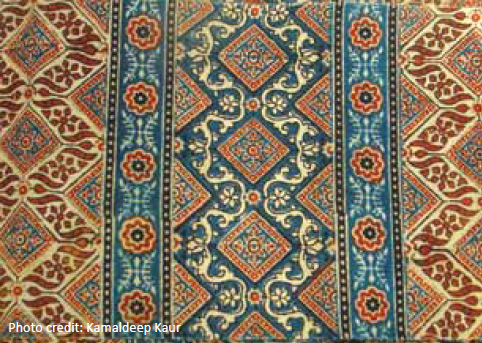
The first village where the artists settled was Dhamadka, which was considerably destroyed in the 2001 earthquake. This lead to many changes in the layers of earth and thus the metal content of water also changed, due to which the colours of dyes changed dramatically.
Ajrakh is a very complicated process in which the fabric goes through many stages of dyeing, printing and Mordanting. The traditional colours for Ajrakh are yellow from pomegranate skin, blue from indigo, reddish maroon from madder or Al (which is replaced by synthetic alizarin in present times ), an orange red from madder etc. Today the colour palette has been expanded to include dyes like Rhubarb, henna, ratanjyot, Sappan, etc. In old times, entire household was involved in the various stages of the work. However, now many things are readily available.
The various stages of the Process of Ajrakh
1. Ajrakh process-resist called Kariyanu is printed
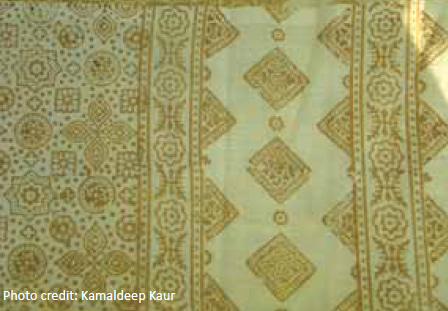
2. Ajrakh process – Iron mordant called kaat is printed, after printing the resist
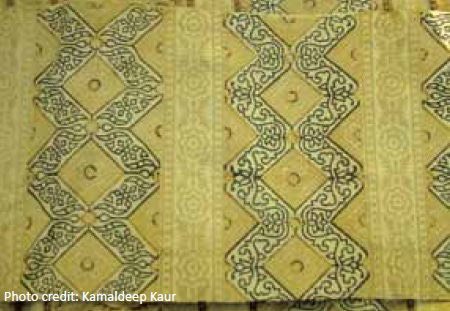
3. Ajrakh process -alum mordent resist called gach is printed
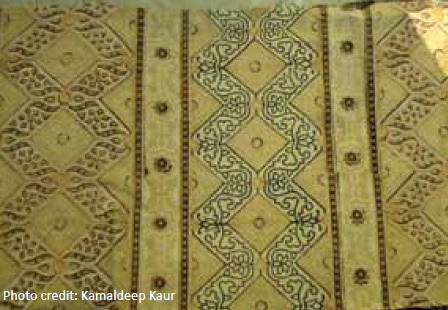
4. Ajrakh process – Indigo dyeing is done and then the fabric is printed again with resist to protect the indigo colour.
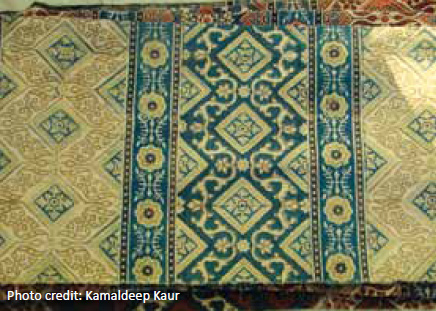
5. Ajrakh process-resist application for Alizarin dyeing
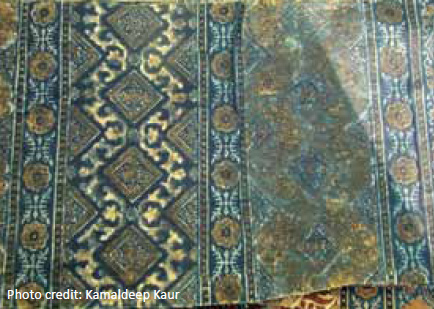
Final design – This portion is the border portion on the Ajrakh, worn on the shoulder as a shawl or chaddar by men, or as a Lungi, a wrap around by men.
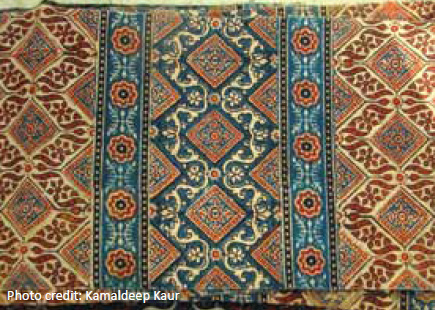
1. Colour is available in powder form, which was earlier ground at home by the women of the family.
2. Earlier Chapri was made at home using simple wooden sticks, but today it is ready made and made of metal.
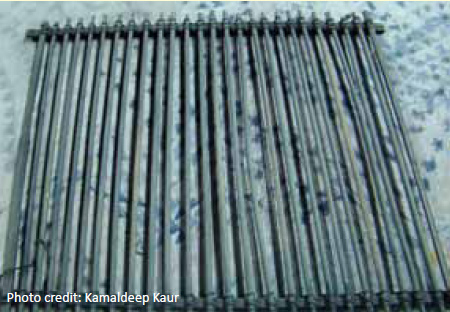
Wooden chapri made at home
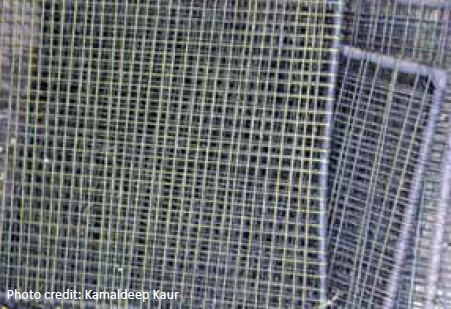
Metal mesh for the same purpose sourced from outside.
Due to these changes and the conscious preservation of the craft by loving practioners, the market for Ajrakh has expanded considerably within the nation and internationally.
Rogan printing in Rajasthan and Gujarat
Hajji Ilahi Baksh and Hajji Rahim Baksh and their wives (who used to travel with them) were very famous for Rogan printing. They carried a small number of blocks and basic colouring material with them and would temporarily rent places to make the fabrics, wherever they went. Earlier, Rogan was printed using only two colours gold and silver, while the base colour of the fabric kept on changing. Presently copper and bronze powder is also being used.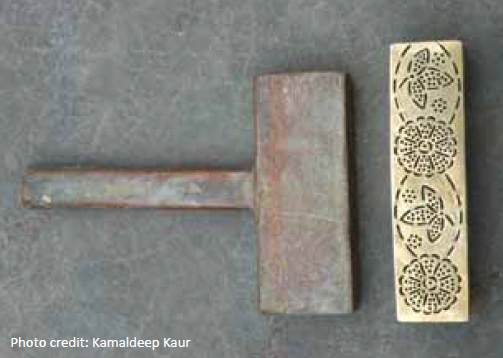
The process was very tedious due to many reasons – making the Rogan paste is a long process. The blocks are very small sized and hollow. They are individually filled with the Rogan paste for printing. It took a few hours to print two and half meters of fabric, which needed 2 days in the sun to become fast enough by the sun’s heat.
Process of Rogan
1. Rogan paste being filled in the hollow cylindrical metal block
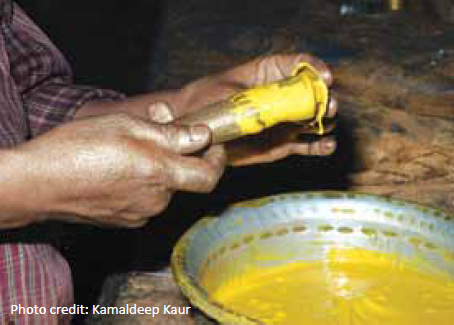
2. Rogan paste being printed on a cotton fabric
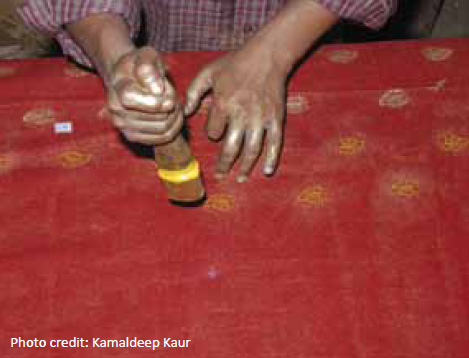
3. Gold dust being sprayed on the wet paste, so that it sticks very quickly
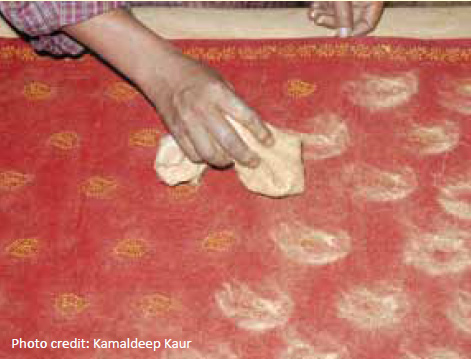
4. The extra gold dust is being brushed off
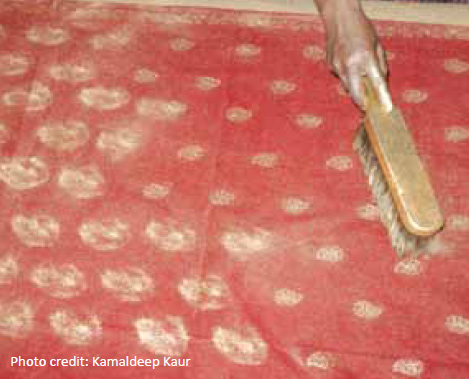
5. The printed fabric is being dried in the sun
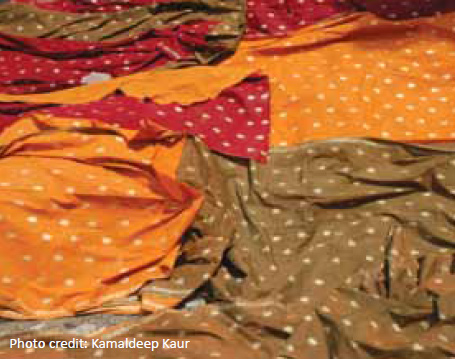
The blocks are made from copper and research says that there might be only one person in Banaras who could make these now.
Saudagiri printing
Saudagiri printing is a very unique style of printing, which was practiced many decades back in Gujarat; some sources mention that it was practised in Rajasthan also. In old times the product made using Saudagiri were Safas and Chunaris, i.e., Turbans and shawls. The fabric used was very fine Malmal or coarse and thick fabric for yardages. A good amount of starch was applied to the fabric to make it look very hard. These products were meant basically for the south east Asian market mainly Thailand. Saudagar literally means – trader, and Saudagiri
-a product made for the traders.
1. A block design for Saudagiri printing – Private collection Fakruddin printers Ahmedabad
2. Border design for Saudagiri blocks, private collection Yasin bhai Sawajiwala, whose forefathers were involved in Saudagiri printing.
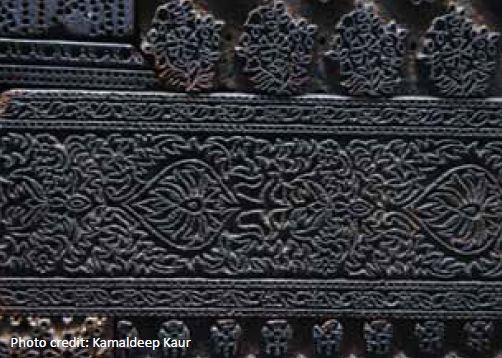
The size of the blocks used in Saudagiri printing is very small, starting from 3”x4” to 6”x6”. The natural dyes used were developed from Myrobalan, Alizarin, henna, pomegranate skin, madder, iron, alum, etc. Chrome colours were also used in between to enhance the beauty of the product; these were only applied in borders i.e., Nakshi. The fabric was spread under sun or on the riverbed, after application of chrome colours, for 3-4 days.
Water was than sprinkled multiple times every day for the next three to four days. Eighty people were required to prepare 125 pieces in about two months.
Textile printing industry: screen printing to survive
As the demand for printed fabrics increased, printing with wooden blocks has become more complicated. In earlier times Kalamkaari blocks were used only for outline work and the filling of colour was done by hand using brushes or painting using various other methods. However, with time, these have given way to wood screens with a nylon mesh. Screen printing, although partly mechanized is still considered to be hand printing and can be used to produce larger volumes of printed fabrics.
Leave a Reply